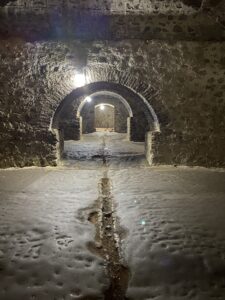by Siddharth Kara
Pulitzer Prize-finalist Siddharth Kara visited the Gold Coast in Africa while doing research on the British slave trade for his book, The Zorg. In The Zorg, using primary source research and investigative skills, Kara reveals how an incident on the Zorg slave ship led to the abolition of slavery in the UK and sparked the US abolitionist movement. Below, Kara shares with The History Reader the role of Ghana’s Cape Coast Castle in the British slave trade as well as what unfathomable misery captured men, women, and children experienced there in the Castle’s dungeons as they waited to be sold to a slave-ship captain.

The entrance to the dungeon at Cape Coast Castle in Ghana is located at the northwest corner of the courtyard, directly below the chapel. Now a haunting museum, the castle was once the headquarters for British slave-trading operations along the Gold Coast beginning in 1664. A low, arched entry gate of the dungeon opens to a downward sloping tunnel into a subterranean cavern consisting of several chambers. African men were imprisoned in the chambers at one side of the dungeon, and women and children at the other. Each chamber had only one ventilation shaft, which was also used to drop food and water to the slaves.
There is only one extant biographical account of the dungeon at Cape Coast Castle written by a former slave, Ottobah Cugoano. Cugoano was born in 1757 in the village of Agimaque, about forty miles northeast of Cape Coast. Around the age of thirteen, he was “kidnapped and betrayed by some of my own complexion,” marched to the coast with many “miserable countrymen chained two by two, some handcuffed, and some with their hands tied behind.” He was then sold to the British for “a gun, a piece of cloth, and some lead.” A disconsolate Cugoano was “soon conducted to a prison” in Cape Coast Castle, where he:
…heard the groans and cries of many, and saw some of my fellow captives. But when a vessel arrived to conduct us away to the ship, it was a most horrible scene; there was nothing to be heard but rattling of chains, smacking of whips, and groans and cries of our fellow men. Some would not stir from the ground, when they were lashed and beat in the most horrible manner…we were taken in the ship that came for us, to another that was ready to sail from Cape Coast.

During my visit to Cape Coast Castle, my guide showed me a roped-off part of the dungeon’s floor that had been left just as it was from Cugoano’s time. It had a slick layer of stone atop the cobbled surface, or so I thought. My guide explained it wasn’t stone, it was several inches of the sedimented blood, urine, fecal matter, and tears of countless Africans who had once languished in that place. I placed my hand on the ground and could not fathom the misery contained in this dungeon across centuries of the Atlantic slave trade.
Cape Coast Castle was just one of the many historic sites I investigated to recount the story of the Zorg. The ship spent five months in 1781 trolling the Gold Coast, acquiring 442 Africans to transport to Jamaica. Many of these Africans were purchased from the nearby British fort at Anomabu, which had the only auction room for slaves of any British fortification in the region. Records show that almost 300,000 Africans were auctioned at Anomabu to slave-ship captains. Many of these Africans had already endured grueling marches for months from inland regions. “I believe the bulk of them are brought from far,” noted the British captain turned Evangelical preacher, John Newton. “I have reason to think, that some travel more than a thousand miles before they reach the sea-coast.”
As the Zorg tracked west across the Atlantic Ocean, foul weather and poor navigation led the journey to take more than twice as long as it should have. Water became scarce, and to save themselves the crew resorted to an appalling act of inhumanity. No one should have ever found out. However, the greed of the ship’s owners led them to file an unprecedented legal claim. The subsequent proceedings put the barbarities of the slave trade into the public sphere for the first time. In the highest court in the British Empire, unprecedented questions were finally being asked: were the Africans people or property? Were they human beings or animals?
The nascent abolitionist movement in England seized on the revelations, and the first movement to abolish slavery was born. This great campaign would overcome tremendous obstacles, eventually achieving the abolition of slavery in the British Empire in 1833, followed by America in 1865. The Zorg was the spark that lit the fire that made freedom inevitable.
The Zorg is perhaps the most consequential slave ship ever to cross the Atlantic, but few people know about the ship. Worse still, the existing historical record on the Zorg is filled with inaccuracies. As I studied thousands of ink-blotted pages of archival materials in England and the Netherlands to try and piece together the Zorg’s journey, I felt driven to recount this pivotal episode with as much accuracy as possible. Some threads I pulled on went nowhere, and others led me to precious discoveries. For instance, I came across a parchment in the British National Archives that revealed a single moment between one of the Zorg’s crew members and an enslaved African that seemed to distill the entire Atlantic slave trade into a single moment of boundless inhumanity. This moment is one of many that have been either obscured or lost over the passage of time.
I hope The Zorg will bring readers a deeper understanding of Atlantic slavery and how the ship’s fateful voyage inspired the first movement to abolish it.

SIDDHARTH KARA is an author, researcher, and activist on modern slavery. Kara has written several books and reports on slavery and child labor, most recently the New York Times bestseller and Pulitzer Prize finalist, Cobalt Red. Kara also won the Frederick Douglass Book Prize. He has lectured at Harvard University and held a professorship at the University of Nottingham. He divides his time between Los Angeles and London.